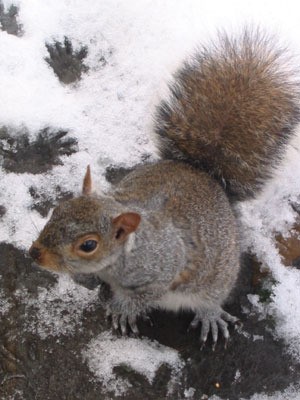
When winter weather arrives, gardeners can keep warm by staying indoors. The wildlife in our garden doesn't have it so easy. They either find a way to cope with the cold or they die. Here are three strategies animals use for coping with the cold and what you can do to help them through the winter.
Animals generally use one of three strategies for coping with the cold. They either stay where they are and adapt to changing conditions, they conserve their energy by hibernating, or they migrate to a more hospitable environment.
Adaptation: To remain active in their environment, animals adapt to cold weather in a number of ways. To keep warm, mammals like deer and rabbits grow a thicker coat of hair. Others adapt by modifying their diet. For example, the red fox normally eats insects and fruit. As these foods become scarce in the winter, they switch to small rodents. To avoid becoming a featured entrée on the new winter menu, hares and weasels have adapted by turning white to blend in with their surroundings.
Hibernation: Many garden animals hibernate for at least part of the winter. To conserve energy, their heartbeat and breathing slows down and their body temperature drops. After bulking up in the fall, they store extra food as body fat and sleep off these reserves over winter. Bats, chipmunks, and skunks sleep away the coldest parts of the winter, but come out in search of food and water on warm, sunny days. Squirrels, mice, and voles also spend the coldest parts of the winter napping, but rely on the food they gathered in the fall to get them through to spring.
Reptiles and amphibians find a spot safe from predators and enter a dormant state known as diapause (similar to hibernation). Certain species of insects (e.g. bumble bees and slugs) go into a similar sleepy state called topor.
Migration: Without the ability to adapt or hibernate, many animals have no choice but to relocate for the winter season. When we think of the word migration we usually think of birds, but in fact some species of bats and garden insects migrate, too. Monarch butterflies from the U.S. and Canada, for example, may fly several thousand miles to spend the winter in Mexico. Worms (and garden pests like termites and Japanese beetles) migrate several feet under ground. Fish living in lakes and ponds migrate to deeper water.
There are several ways to make a hard winter easier on wildlife. Turning your yard into a winter wildlife refuge will increase your opportunities to observe nature, and it's a great way to repay the animals and insects for the vital role they play in your garden the rest of the year.
Provide Shelter: The key to providing wildlife with suitable winter shelter is to create areas in the yard that contain plenty of nooks and crannies. Start a compost pile or create mounds out of mulch or loose top soil near the edges of the garden. Piles of rocks, logs, brush, straw or even tree leaves will be appreciated by small mammals, lizards and snakes. Instead of throwing out cracked or chipped terra-cotta pots, flip them over and place them under trees and shrubs for ready-made 'toad abode.' Unless you've recently suffered from an infestation of garden pests, leave plant debris intact until spring to shelter beneficial insects like earwigs, and ladybeetles. A discarded Christmas tree will protect perennial plants and provide shelter to a variety of backyard wildlife. Offer refuge to flying friends by hanging up a variety of bat and birdhouses.
Feed & Water the Birds: Snow and icy temperatures often make it difficult for resident wildlife to find food and water-especially birds-who burn vast amounts of energy just trying to stay warm. Add high energy foods like suet and oily nuts to backyard feeders. Because it takes energy to turn snow into water, consider using a heated birdbath during the winter months to help birds conserve their energy.
Grow Berries and Fall Fruiting Plants: Once you start feeding seed to backyard birds, they continue to rely on you as a food source rather than searching for their own. To avoid this, plant a variety of berries and fruiting plants that will supply birds with their own source of food. Try cherry trees, dogwood, elderberries, juniper, viburnum, echinacea, wild roses, sunflowers, rudbeckia, and ornamental grasses.
Avoid Close Encounters: Creating cozy spots for animals to overwinter in the garden can result in some close encounters. Driven by hunger, many animals will exhibit less cautious behavior in order to gain access to food. Try to observe animals from a distance, preferably from indoors. By avoiding contact and keeping noise to a minimum, you'll help to ensure they don't use up their valuable energy stores by fleeing from human disturbance.

About The Author: Ellen Brown is our Green Living and Gardening Expert. Click here to ask Ellen a question! Ellen Brown is an environmental writer and photographer and the owner of Sustainable Media, an environmental media company that specializes in helping businesses and organizations promote eco-friendly products and services. Contact her on the web at http://www.sustainable-media.com
Add your voice! Click below to comment. ThriftyFun is powered by your wisdom!
Thank you for posting this. I am always so concerned for all animals where it is in the freezing cold or the hot, hot summers.
Thank you for the tips, I will be sure to use them.
My husband and I have for many years, provided shelter, food and water to wildlife in our backyard. I just wish our neighbors would keep their cats indoors to avoid the wildlife from being attacked by the cats.
Add your voice! Click below to comment. ThriftyFun is powered by your wisdom!